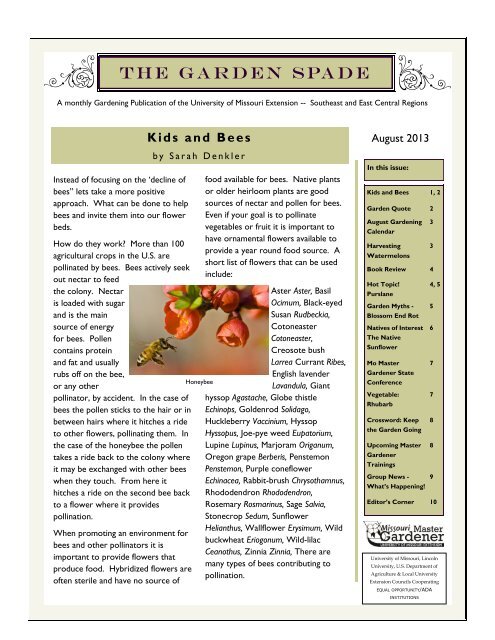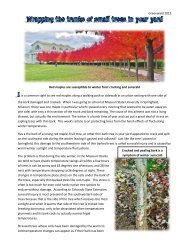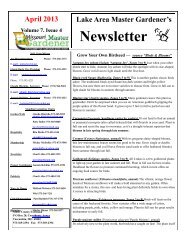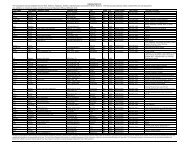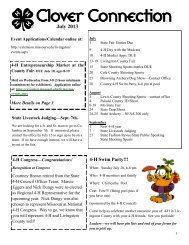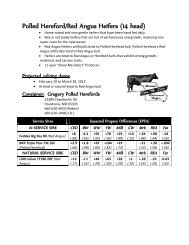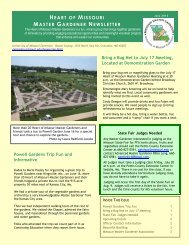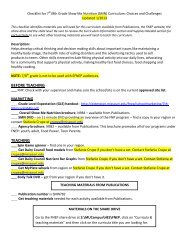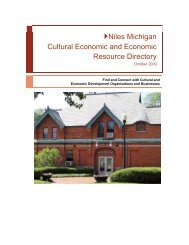August 2013 - University of Missouri Extension
August 2013 - University of Missouri Extension
August 2013 - University of Missouri Extension
You also want an ePaper? Increase the reach of your titles
YUMPU automatically turns print PDFs into web optimized ePapers that Google loves.
The Garden Spade<br />
A monthly Gardening Publication <strong>of</strong> the <strong>University</strong> <strong>of</strong> <strong>Missouri</strong> <strong>Extension</strong> -- Southeast and East Central Regions<br />
Instead <strong>of</strong> focusing on the ‘decline <strong>of</strong><br />
bees” lets take a more positive<br />
approach. What can be done to help<br />
bees and invite them into our flower<br />
beds.<br />
How do they work? More than 100<br />
agricultural crops in the U.S. are<br />
pollinated by bees. Bees actively seek<br />
out nectar to feed<br />
the colony. Nectar<br />
is loaded with sugar<br />
and is the main<br />
source <strong>of</strong> energy<br />
for bees. Pollen<br />
contains protein<br />
and fat and usually<br />
rubs <strong>of</strong>f on the bee,<br />
or any other<br />
pollinator, by accident. In the case <strong>of</strong><br />
bees the pollen sticks to the hair or in<br />
between hairs where it hitches a ride<br />
to other flowers, pollinating them. In<br />
the case <strong>of</strong> the honeybee the pollen<br />
takes a ride back to the colony where<br />
it may be exchanged with other bees<br />
when they touch. From here it<br />
hitches a ride on the second bee back<br />
to a flower where it provides<br />
pollination.<br />
When promoting an environment for<br />
bees and other pollinators it is<br />
important to provide flowers that<br />
produce food. Hybridized flowers are<br />
<strong>of</strong>ten sterile and have no source <strong>of</strong><br />
Kids and Bees<br />
b y S a r a h D e n k l e r<br />
Honeybee<br />
food available for bees. Native plants<br />
or older heirloom plants are good<br />
sources <strong>of</strong> nectar and pollen for bees.<br />
Even if your goal is to pollinate<br />
vegetables or fruit it is important to<br />
have ornamental flowers available to<br />
provide a year round food source. A<br />
short list <strong>of</strong> flowers that can be used<br />
include:<br />
Aster Aster, Basil<br />
Ocimum, Black-eyed<br />
Susan Rudbeckia,<br />
Cotoneaster<br />
Cotoneaster,<br />
Creosote bush<br />
Larrea Currant Ribes,<br />
English lavender<br />
Lavandula, Giant<br />
hyssop Agastache, Globe thistle<br />
Echinops, Goldenrod Solidago,<br />
Huckleberry Vaccinium, Hyssop<br />
Hyssopus, Joe-pye weed Eupatorium,<br />
Lupine Lupinus, Marjoram Origanum,<br />
Oregon grape Berberis, Penstemon<br />
Penstemon, Purple coneflower<br />
Echinacea, Rabbit-brush Chrysothamnus,<br />
Rhododendron Rhododendron,<br />
Rosemary Rosmarinus, Sage Salvia,<br />
Stonecrop Sedum, Sunflower<br />
Helianthus, Wallflower Erysimum, Wild<br />
buckwheat Eriogonum, Wild-lilac<br />
Ceanothus, Zinnia Zinnia, There are<br />
many types <strong>of</strong> bees contributing to<br />
pollination.<br />
<strong>August</strong> <strong>2013</strong><br />
In this issue:<br />
Kids and Bees 1, 2<br />
Garden Quote 2<br />
<strong>August</strong> Gardening 3<br />
Calendar<br />
Harvesting 3<br />
Watermelons<br />
Book Review 4<br />
Hot Topic! 4, 5<br />
Purslane<br />
Garden Myths - 5<br />
Blossom End Rot<br />
Natives <strong>of</strong> Interest 6<br />
The Native<br />
Sunflower<br />
Mo Master 7<br />
Gardener State<br />
Conference<br />
Vegetable: 7<br />
Rhubarb<br />
Crossword: Keep 8<br />
the Garden Going<br />
Upcoming Master 8<br />
Gardener<br />
Trainings<br />
Group News - 9<br />
What’s Happening!<br />
Editor’s Corner 10<br />
<strong>University</strong> <strong>of</strong> <strong>Missouri</strong>, Lincoln<br />
<strong>University</strong>, U.S. Department <strong>of</strong><br />
Agriculture & Local <strong>University</strong><br />
<strong>Extension</strong> Councils Cooperating<br />
EQUAL OPPORTUNITY/ADA<br />
INSTITUTIONS
Honey bees help to pollinate melon, cucumber,<br />
squash, pumpkin, apple, pear, blackberry, blueberry,<br />
cherry, nectarine, peach,<br />
plum and sunflower.<br />
Solitary bees nest in the soil.<br />
These bees pollinate<br />
blueberries and early<br />
blooming plants because they<br />
emerge earlier in the year<br />
than other bees. They also<br />
pollinate squash, pumpkin<br />
and gourd. Because they<br />
nest in soil their nests can be<br />
damaged by tilling or<br />
plowing, affecting the bee population.<br />
Other solitary bees nest in<br />
holes that are 5/16-3/8 inch<br />
wide. These bees can be found<br />
in reeds, wood holes and old<br />
beetle tunnels. If you want to<br />
promote these bees which help<br />
to pollinate apples and other<br />
fruit, hang up a pvc tube that<br />
has been filled with straw tubes<br />
and see if your made from<br />
scratch home attracts bees.<br />
Place these ‘homes’ out in the<br />
spring and make sure the tunnels are larger than<br />
5/16 inch.<br />
Bumblebees, the large black and yellow bees, make<br />
Kids and Bees<br />
Secondar y Stor y Headline<br />
b y S a r a h D e n k l e r<br />
Bumblebee<br />
Carpenter Bee - note the shiny abdomen<br />
homes in old rodent nests or cavities in plant<br />
debris or in soil. Bumblebees pollinate fruit and<br />
vegetables and are especially useful on windy or<br />
rainy days when smaller bees<br />
can not fly. These bees can<br />
buzz over a flower and<br />
release pollen from their<br />
bodies aiding pollination.<br />
Carpenter bees make their<br />
homes in wood. They have<br />
the look <strong>of</strong> a bumblebee but<br />
have a shiny abdomen<br />
(waste). These bees are not<br />
desirable pollinators as they<br />
damage the flower to reach the nectar. Work to<br />
plug up their tunnels if you find them.<br />
Other pollinators are not<br />
actively looking for pollen but<br />
because they feed on nectar<br />
they aid in pollination <strong>of</strong> specific<br />
flowers. Flies are attracted to<br />
flowers that smell bad,<br />
butterflies are attracted to flat<br />
flowers, moths and bats may<br />
pollinate flowers that are open<br />
at night, hummingbirds look for<br />
trumpet shaped flowers while<br />
beetles and ants crawl around<br />
feeding on other insects. Birds, and hover flies feed<br />
on nectar in any type <strong>of</strong> flower as do wasps.<br />
Garden Quote<br />
Flowers always make people better, happier, and<br />
more helpful; they are sunshine, food and medicine<br />
for the soul.<br />
~ Luther Burbank<br />
The Garden Spade Page 2
<strong>August</strong> Gard ening Calendar<br />
B y D o n n a A u f d e n b e r g<br />
Vegetable Gardening<br />
Keep the garden well-watered during dry weather and free <strong>of</strong> weeds, insects,<br />
and disease.<br />
Complete fall garden planting with cool season transplants early this month.<br />
Lettuce, spinach, and radishes can be planted in mid-<strong>August</strong>.<br />
Pick beans, tomatoes, peppers, and squash <strong>of</strong>ten to<br />
encourage further production.<br />
Plant a cover crop to enrich your soil. Annual rye,<br />
red clover and hairy vetch are good choices.<br />
Compost plant materials from the garden as crops<br />
are harvested. Avoid composting any plants that are<br />
disease or insect infested.<br />
Outdoor Flowering Plants and Ornamentals<br />
Perennials that have finished blooming should be<br />
deadheaded.<br />
Keep weeds from making seeds now! This will<br />
mean less weeding for next year.<br />
During hot, dry weather, keep soil cultivation at a minimum. Loosening the<br />
soil under these conditions reduces water uptake and makes plants look<br />
much worse than before.<br />
Keep newly established plants well-watered when weather is dry.<br />
Check trees and shrubs that have been planted in recent years for girdling<br />
damage by guy wires, burlap or ropes.<br />
Don’t fertilize woody plants now. It stimulates late growth that will not have<br />
time to harden-<strong>of</strong>f properly before winter.<br />
Fruits and Nuts<br />
If your apples are lumpy they may have apple maggots. Be sure that fruit is<br />
not left lying on the ground because the maggots live in fallen apples and then<br />
pupate in the soil.<br />
Heavy rains at harvest can dilute the sugars in melons. Watermelons can reconcentrate<br />
the sugar if left for a few dry days however cantaloupes cannot<br />
do this.<br />
To reduce the number <strong>of</strong> pests on your fruit tree for the coming year, pick<br />
up and destroy all fallen fruit. Worms hide in the fruit and then pupate into<br />
the soil. They will be ready to lay eggs next year.<br />
Harvesting<br />
Watermelons<br />
Harvest watermelon<br />
when several<br />
factors indicate<br />
ripeness.<br />
The underside<br />
ground spot turns<br />
from whitish to<br />
creamy yellow.<br />
The light green,<br />
curly tendrils<br />
closest to the<br />
melon turn brown<br />
and shrivel.<br />
The rind loses its<br />
gloss and appears<br />
dull and becomes<br />
resistant to<br />
penetration by the<br />
thumbnail and is<br />
rough to the touch<br />
The melon yields a<br />
dull thud sound<br />
rather than a ringing<br />
sound when<br />
thumped. This is<br />
not always so<br />
reliable!<br />
Lawn<br />
Apply insecticides this month for grub control on lawns damaged by their<br />
activity.<br />
Start thinking about lawn renovation the last week in <strong>August</strong>. Consider<br />
having a soil test to determine fertility needs.<br />
The Garden Spade<br />
Page 3
Book Review<br />
Secondar y Stor y Headline<br />
b y M a r c y W r i g h t , M a s t e r G a r d e n e r<br />
Book: The Heirloom Life Gardener by Jere and<br />
Emilee Gettle<br />
I have never thought about planting heirloom<br />
vegetables, but gardeners Jere and Emilee Gettle<br />
inspire me to do just that.<br />
Jere’s passion for gardening comes<br />
out as he describes growing up in a<br />
homestead family, living <strong>of</strong>f the land<br />
during the 1980’s, it was all about<br />
convenience. You really feel the<br />
uniqueness <strong>of</strong> this family. As Jere<br />
grows up, he sees historic varieties<br />
disappearing from the seed catalogs he spent so<br />
many hours dreaming over. There is a need to<br />
preserve history and at the age <strong>of</strong> 18, he starts<br />
Baker Creek Seed Company. Their first catalog<br />
was twelve pages long and <strong>of</strong>fered seventy-five<br />
varieties <strong>of</strong> seed.<br />
Feel the heat and see the sights as you travel with<br />
Jere through Mexico while hunting down roadside<br />
markets. Not able to speak Spanish, he still is able<br />
to communicate with the vendors’ his love for<br />
seeds. As he finds new vegetables, he hacks them<br />
open with a machete, scooping out the seeds to<br />
dry and save.<br />
Not only do you get to know the Gettle’s on a<br />
personal level, you gain valuable insights and<br />
information on how to garden. Pick up tips on how<br />
to prepare the soil (they use fresh poultry manure).<br />
Learn about their organic weed control (mulch,<br />
mulch, mulch). Discover tidbits on when to<br />
harvest (when are Brussels sprouts ready?). Oh<br />
the advice!<br />
Last but not least, Jere and Emilee have picked their<br />
fifty favorite vegetables and provide in-depth<br />
information on growing, pests, diseases, seed saving<br />
and cooking for each one. I can’t wait to grow<br />
some ground cherries! They sound fantastic.<br />
I borrowed this book from a fellow gardener and<br />
have enjoyed reading it from cover to cover. I<br />
can’t wait to get my own copy. Not only do Jere<br />
and Emilee tell an amazing story but you gain<br />
beneficial, practical tips that you can easily<br />
incorporate into your own garden.<br />
Hot Topic! Purslane<br />
b y K a t i e K a m m l e r<br />
Last summer I got a call about purslane. My first<br />
thought was the guy wanted to know how to get<br />
rid <strong>of</strong> it because it is a common<br />
garden weed in the summertime.<br />
Actually he wanted to know how<br />
to identify it so he could grow and<br />
eat it. I had no idea it was an<br />
edible plant so I will let you decide<br />
if you consider it a friend or foe in<br />
your garden.<br />
This time <strong>of</strong> year, most people can<br />
walk in their garden or yard and find purslane<br />
(Portulaca oleracea). Purslane is a native <strong>of</strong> India and<br />
Persia and has spread throughout the world as an<br />
edible plant and as a weed. Purslane has fleshy<br />
succulent leaves similar to Jade<br />
plants and yellow flowers. The<br />
stems lay flat on the ground and<br />
radiate from a single taproot<br />
forming a large mat <strong>of</strong> leaves. It is<br />
closely related to moss rose,<br />
Portulaca grandiflora, grown as an<br />
ornamental. Purslane is an annual<br />
that will reproduce from seeds and<br />
from stem pieces. The seeds can remain viable in<br />
the soil for 40 years so this can either be<br />
depressing or exciting<br />
………..Continued on page 5<br />
The Garden Spade Page 4
Myths - Cure for Blossom End Rot<br />
Secondar y Stor y Headline<br />
b y S a r a h D e n k l e r<br />
Magnesium sulfate cures blossom end rot on<br />
tomato. The question may sound like this, “My<br />
friend says Epsom salts (magnesium sulfate) cure<br />
blossom end rot in tomato plants because it<br />
adds magnesium...Is this true? “<br />
Blossom end rot happens when the fruit<br />
or vegetable is produced without<br />
sufficient calcium to do so. The calcium<br />
may be available in the soil or even in<br />
the plant but it is not located in the fruit<br />
or vegetable while they form.<br />
The reason for this is <strong>of</strong>ten weather related. If the<br />
plants were set out when the weather was too<br />
cool this could have set back plant development or<br />
they may not have produced an extensive root<br />
system. If the weather becomes too dry and water<br />
is not moving through the plant on a regular<br />
schedule then the calcium may not be getting<br />
where it needs to go. If the plants have high levels<br />
<strong>of</strong> nitrogen and produce excess foliage it can<br />
prevent calcium from moving to the blossom. If it<br />
is too humid (a real issue in <strong>Missouri</strong>) then the<br />
calcium may not be moving through the plant. If<br />
anything hurts the root system then uptake <strong>of</strong><br />
calcium may not be happening.<br />
Notice in each case I refer to calcium. This is the<br />
nutrient that is out <strong>of</strong> balance when there is<br />
blossom end rot, not magnesium. Sometimes<br />
blossom end rot will occur on the fruits or<br />
vegetables that develop first but will<br />
not persist thereafter.<br />
In cases where magnesium sulfate<br />
(Epsom salts) have made a difference in<br />
plant health there has been a deficiency<br />
in magnesium, not calcium. The<br />
situations have also been on high production,<br />
commercial ventures where nutrients are leached<br />
out due to high irrigation schedules such as in<br />
sandy locations.<br />
A further issue that can arise from using Epsom<br />
salts is using it in the form <strong>of</strong> a spray on foliage.<br />
This has been proven to cause leaf scorch and is<br />
not recommended.<br />
The best solution for blossom end rot is to do a<br />
soil test. If this condition has persisted for more<br />
than one year then test for more than just N, P, K<br />
and Ca. Find out if there is an imbalance <strong>of</strong><br />
another nutrient. An imbalance may be reducing<br />
root formation and causing delay in calcium<br />
movement through the plant.<br />
Hot Topic! Purslane ( c o n t ’ d f r o m p a g e 4 )<br />
b y K a t i e K a m m l e r<br />
depending on your definition <strong>of</strong> the plant.<br />
If you consider it a weed and are trying to control<br />
it, the number one thing is not to let it go to seed.<br />
It only takes three weeks for plants to get big<br />
enough to produce seed so you have a short<br />
window <strong>of</strong> time to control it. Also plants that are<br />
cut up by tilling or hoeing can re-root into the soil.<br />
Purslane is not picky and will grow just about<br />
anywhere from the best garden soil to the poorest<br />
dry soil. It thrived last year in the drought because<br />
<strong>of</strong> its succulent leaves. The seeds are very small so<br />
they germinate best in the top ½ inch <strong>of</strong> soil and<br />
they like warm soil temperatures so mulching can<br />
help prevent germination.<br />
Now back to the other side <strong>of</strong> purslane, its<br />
edibility. The preference is to eat fresh young<br />
plants, especially young leaves and tender stem tips.<br />
The taste is similar to watercress or spinach. It can<br />
be used in salads or sandwiches. It can also be<br />
steamed, stir-fried, or pureed. Now it is up to you<br />
to decide if you want to weed it or eat it!<br />
The Garden Spade Page 5
Natives Of Interest —The Sunflower<br />
Secondar y Stor y Headline<br />
b y S a r a h D e n k l e r<br />
When many <strong>of</strong> us picture the sunflower we picture<br />
a large seed head positioned alone on an 8 to 12<br />
foot tall flower stem. Yellow rays surround a black<br />
center which produces large, edible seeds. This<br />
picture is <strong>of</strong> a version <strong>of</strong> the sunflower which has<br />
developed over time<br />
from the native<br />
sunflowers found in<br />
<strong>Missouri</strong> and other<br />
areas <strong>of</strong> America.<br />
The Native<br />
Americans were the<br />
first to domesticate<br />
the sunflower relying<br />
heavily on it as a<br />
source <strong>of</strong> food from<br />
900 to 1700 A.D.<br />
Some evidence even<br />
suggests it was used<br />
as far back as 3000 Helianthus annuus ‘Claret’ - Courtesy<br />
B.C. The Native <strong>of</strong> Royal Horticultural Society<br />
Americans developed the plant into a single stem<br />
with black, white, red and striped seed colors. The<br />
plant was taken to Spain in 1500 A.D. and moved<br />
further into Russia around the 1700’s were it was<br />
developed into an oil for consumption. From here<br />
it returned to the U.S. in the late 1800’s as the<br />
large flower heads we recognize today.<br />
This originated with the varied native species that<br />
can still be collected today and planted for<br />
ornamental value. A few <strong>of</strong> the many species <strong>of</strong><br />
Helianthus are shown here.<br />
<br />
<br />
Helianthus ‘Loddon gold’ is a perennial with a<br />
unique yellow bloom. With a two foot stem<br />
the clump forming plant can be divided in<br />
autumn or spring. This plant likes hot weather.<br />
Helianthus maximillianii has many three inch<br />
perennial flowers on a 10 foot tall stem. This<br />
would make a big impact in an open space such<br />
as a prairie setting.<br />
<br />
<br />
<br />
<br />
<br />
<br />
<br />
<br />
<br />
<br />
<br />
Helianthus angustifolius or swamp sunflower<br />
likes moist areas near creek beds<br />
Helianthus divaricatus is a clump forming<br />
woodland perennial that has many small yellow<br />
blooms July to September. It reaches a height<br />
<strong>of</strong> six feet and spreads by rhizomes.<br />
Helianthus debilis is an annual that produces a<br />
five inch white bloom on a six foot stem<br />
preferring moist soils.<br />
Helianthus annuus ‘claret’ is an annual with deep<br />
red petals and a six inch bloom reaching six<br />
feet in height in full sun. It produces no pollen.<br />
Helianthus annuus ‘cocoa sun’ is an annual that<br />
reaches a height <strong>of</strong> one foot with bright yellow<br />
blooms and a dark center.<br />
www.americanmeadows.com<br />
www.easylivingwildflowers.com<br />
www.everwilde.com<br />
www.prairienursery.com<br />
www.seedsource.com<br />
www.wildflowerfarm.com<br />
Helianthus ‘Loddon<br />
Gold’ - Courtesy <strong>of</strong><br />
Royal Horticultural<br />
Society<br />
Sunflowers may<br />
be purchased<br />
from many<br />
sources. The<br />
following list is<br />
provided for your<br />
information and is<br />
in no way<br />
indorsed by<br />
<strong>Extension</strong>.<br />
Check out more on the sunflower at: History <strong>of</strong><br />
the Amazing Sunflower. National Sunflower<br />
Association. http://www.sunflowernsa.com/allabout/history/.<br />
July 17, <strong>2013</strong><br />
The Garden Spade Page 6
<strong>Missouri</strong> Master Gardener State Conference<br />
Secondar y Stor y Headline<br />
“It's a Garden Party! Sept. 20-22, <strong>2013</strong>”<br />
It's a Garden Party! The Master Gardeners <strong>of</strong><br />
Greene County are gearing up to host the 18th<br />
Annual Master Gardener State Conference<br />
September 20-22, <strong>2013</strong> in the Springfield, MO.<br />
area. Read about it at missourimastergardener.org.<br />
You're invited to expand your gardening<br />
knowledge, enjoy an entertaining evening with Dr.<br />
F. Todd Lasseigne <strong>of</strong> the Oklahoma Centennial<br />
Botanical Garden, and tour our new headquarters<br />
at the beautiful Springfield-Greene County<br />
Botanical Center & Gardens<br />
and private area gardens.<br />
The Ramada Oasis Hotel &<br />
Convention Center in<br />
Springfield will be the conference hotel and site <strong>of</strong><br />
advanced training, workshops, and gardening<br />
exhibitors. You won't want to miss the Friday night<br />
social and open house either. Learn about the<br />
conference and reserve a spot by registering online<br />
at: missourimastergardener.org.<br />
Vegetable Crop: Rhubarb<br />
b y K a t i e K a m m l e r<br />
Rhubarb is one <strong>of</strong> my favorite garden plants,<br />
probably because I really like to bake with it!<br />
Unfortunately my plant did not survive the drought<br />
last year so it is on my list <strong>of</strong> plants to purchase.<br />
Rhubarb is a cool season, perennial vegetable,<br />
grown for its leafstalks that<br />
have a unique tangy taste used<br />
for pies, baked goods, and<br />
sauces. Rhubarb was first<br />
cultivated in the Far East more<br />
than 2000 years ago for<br />
medicinal purposes. Only<br />
since the 18 th century has it<br />
been grown for culinary use in<br />
the US and Britain.<br />
Rhubarb will grow and produce in most soils, but<br />
grows best in fertile, well-drained soil with lots <strong>of</strong><br />
organic matter. Since it is a perennial, it should be<br />
planted to one side or at the end <strong>of</strong> the garden so<br />
it is out <strong>of</strong> the way and not disturbed. It needs full<br />
sun and a southern exposure provides for an<br />
earlier crop.<br />
Rhubarb is generally planted from a crown or<br />
division, not from seed. Planting in early spring is<br />
best, either when the plants are still dormant or<br />
when they are just starting to leaf out. It can also<br />
be planted in the fall after dormancy has set in.<br />
Water regularly until it is established and also<br />
during dry periods. Rhubarb is a heavy feeder and<br />
benefits from regular fertilizer applications.<br />
Mulching helps control weeds and conserves soil<br />
moisture.<br />
Leaf stalks should not be<br />
harvested the first year and<br />
only a few the second year.<br />
Once it is established from the<br />
third year on, it can be<br />
harvested in May to June. Stop<br />
harvesting leafstalks when the<br />
plant begins to produce<br />
slender stalks, a sign that its<br />
reserves are low. Never harvest more than 1/3 to<br />
½ <strong>of</strong> the plant in order to preserve enough foliage<br />
to maintain the crown. Harvest by grasping each<br />
leafstalk near the base and pulling it slightly to one<br />
side or cut with a knife. The leaf portion needs to<br />
be discarded as it contains oxalic acid. Oxalic acid<br />
can build in the stems if there is frost damage in<br />
late spring. Only eat the stems if they are firm and<br />
upright, discard mushy, s<strong>of</strong>t stems.<br />
Generally there are not many pest problems<br />
associated with rhubarb. Japanese beetles like the<br />
leaves and crown rot can sometimes be an issue.<br />
The Garden Spade Page 7
Crossword! Keep the Garden Going This Summer!<br />
b y D o n n a A u f d e n b e r g<br />
Working in the<br />
garden during<br />
the hot summer<br />
months is vital to<br />
keeping the<br />
garden going<br />
until fall. See if<br />
you can solve this<br />
crossword and<br />
come up with all<br />
the tasks that<br />
must be done to<br />
keep your<br />
produce and<br />
flowers coming!<br />
14<br />
1<br />
2 3<br />
4 5 6<br />
7<br />
8<br />
9 10<br />
11<br />
12 13<br />
15<br />
16<br />
Across:<br />
1 - Water for garden plants<br />
4 - Insects that transmit bacterial wilt to cucumbers<br />
and they come in spots or stripes<br />
7 - Fruits and vegetables past their prime<br />
9 - tool used to eliminate weeds in the garden<br />
11 - Analysis <strong>of</strong> garden soil<br />
12 - Fungus, bacteria or virus causing abnormal<br />
plants<br />
14 - Piled plant debris which is turned for speedy<br />
decomposition<br />
15 - Ripe fruits and vegetables picked for consumption<br />
16 - shield shaped insect with sucking mouth parts<br />
that frequent plants in the cucurbit family<br />
Down:<br />
1 - Critters that chew on leaves or suck leaf juices<br />
2 - Removal <strong>of</strong> weeds<br />
3 - Removal <strong>of</strong> spent blooms<br />
4 - A green manure<br />
5 - A cool season group <strong>of</strong> plants that are commonly<br />
planted for the fall garden<br />
6 - A woven material used to lightly cover plants<br />
to protect from frost<br />
8 - Covering the soil with organic materials<br />
10 - A source <strong>of</strong> N, P, K that keeps the plants in<br />
the garden growing<br />
13 - Touring the garden and inspecting plants for<br />
insect and disease problems<br />
Upcoming Master Gardener Trainings!<br />
b y D o n n a A u f d e n b e r g<br />
Master Gardener Training in Jackson, Tuesdays, Aug 27 th - Nov 12 th at 6:00 p.m. at Cape Girardeau<br />
County <strong>Extension</strong>. Contact Donna Aufdenberg at 573-238-2420 or aufdenbergd@missouri.edu<br />
Master Gardener Training in Farmington, Wednesdays, Aug 14 th - Oct 23 rd at North College<br />
Center, Mineral Area College in Park Hills at 6:00 p.m. Contact Katie Kammler at 573-883-3548 or<br />
kammlerk@missouri.edu.<br />
Master Gardener Core Training in Poplar Bluff, Tuesdays, Aug 13 th - Oct 29 th at 5:00 p.m. at Butler<br />
County <strong>Extension</strong> Center. Contact Sarah Denkler at 573-686-8064 or denklers@missouri.edu<br />
The Garden Spade<br />
Page 8
Group News - What’s Happening<br />
T h e<br />
G a r d e n<br />
S pa d e<br />
<strong>August</strong> <strong>2013</strong><br />
Sun Mon Tue Wed Thu Fri Sat<br />
1 2 3<br />
Contact your local <strong>Extension</strong> Center if you have<br />
questions about any event on the calendar.<br />
4 5 6 7 8 9 10<br />
Parkland MG, 6:30pm @<br />
Memorial United Methodist<br />
Church, Farmington, MO<br />
Poplar Bluff MG, 6:00pm @<br />
Eagle Pass Winery, PB, MO<br />
Ste. Genevieve MG, 6:30pm<br />
@ Ste. Gen. Co. Ext. Center<br />
11 12 13 14 15 16 17<br />
MG Core Training 5-8p;<br />
Butler Co. Ext. Center<br />
Fee: $150<br />
MG Core Training 6-9p;<br />
North College Center,<br />
MAC, Park Hills, MO<br />
Fee: $165<br />
Cape Girardeau MG,<br />
7:00pm @ Cape County<br />
Ext. Center<br />
18 19 20 21 22 23 24<br />
MG Core Training 5-8p;<br />
Butler Co. Ext. Center<br />
Fee: $150<br />
MG Core Training 6-9p;<br />
North College Center,<br />
MAC, Park Hills, MO<br />
Fee: $165<br />
25 26 27 MG Core Training 6-9p; 28 29 30 31<br />
Cape Girardeau Co.<br />
Perry Co. MG 6:30 pm,<br />
Perry Co. Ext. Center<br />
Ext. Center in Jackson,<br />
MG Core Training 5-8p;<br />
Butler Co. Ext. Center<br />
Fee: $150<br />
MG Core Training 6-9p;<br />
North College Center,<br />
MAC, Park Hills, MO<br />
Fee: $165<br />
<strong>August</strong><br />
2 - Parkland MGs 1st Monday at 6:30pm, Memorial United Methodist, Fmgtn, MO<br />
3 - Poplar Bluff MGs 1st Tuesday at 6:00pm, Butler County Ext Center<br />
12 - Ste. Genevieve MGs 2nd Thursday, at 6:30pm, Ste. Gen. County Ext. Center<br />
12 - Delta Area MGs 2nd Thursday at 7:00pm, Medical Arts Building, Sikeston, MO<br />
16 - Cape Girardeau County MGs 3rd Thursday at 7:00pm, Cape County Ext. Center<br />
23 - Perry County MGs 4th Monday at 6:30pm, Perry County Ext. Center<br />
Upcoming Events<br />
September 3 to October 29 - Master Gardener Core Training<br />
Continues; 6-9pm Cape Girardeau Co. Ext. Center in Jackson,<br />
MO<br />
September 4 to October 23 - Master Gardener Core Training<br />
Continues; 6-9pm North College Center, MAC in Park Hills, MO<br />
September 10, 17 and 24 - Master Gardener Core Training<br />
Continues; 5-8pm Butler Co. Ext. Center in Poplar Bluff, MO<br />
If you have a horticultural related event for the calendar call 573-686-8064 or email it to<br />
Denklers@missouri.edu.<br />
The Garden Spade<br />
Page 9
Editor’s Corner<br />
The Garden Spade is published monthly by <strong>University</strong> <strong>of</strong> <strong>Missouri</strong><br />
<strong>Extension</strong> staff for individuals and families living in Southeast and<br />
East Central <strong>Missouri</strong>. This newsletter is provided by your local<br />
extension council.<br />
Editors:<br />
Katie Kammler, Plant Science Specialist<br />
255 Market St., Ste. Genevieve, MO 63670<br />
573-883-3548<br />
Sarah Denkler, Horticulture Specialist<br />
222 North Broadway Street, Poplar Bluff, MO 63901<br />
573-686-8064<br />
Donna Aufdenberg, Horticulture Specialist<br />
304 High Street, PO Box 19, Marble Hill, MO 63764<br />
573-238-2420<br />
We welcome and encourage Master Gardener groups<br />
and individuals to submit items to the newsletter. We<br />
encourage the submission <strong>of</strong> any news such as<br />
upcoming volunteer opportunities, community events<br />
related to gardening, warm wishes or congratulations to<br />
fellow gardeners. We also encourage Master<br />
Gardeners sharing experiences and writing articles on<br />
timely topics.<br />
All entries into the group news sections must be<br />
received by 4:30 on the15th <strong>of</strong> each month for the<br />
following months news.<br />
Email News to: kammlerk@missouri.edu,<br />
denklers@missouri.edu, or aufdenbergd@missouri.edu<br />
Disclaimer: No special endorsement <strong>of</strong> mentioned<br />
products is intended, nor is criticism implied <strong>of</strong> similar<br />
products not mentioned.<br />
<strong>August</strong> <strong>2013</strong> Garden Spade<br />
Ste. Genevieve County <strong>Extension</strong><br />
255 Market St.<br />
Ste. Genevieve, MO 63670<br />
<strong>University</strong> <strong>of</strong> <strong>Missouri</strong>, Lincoln <strong>University</strong>, U.S. Department <strong>of</strong> Agriculture & Local <strong>University</strong> <strong>Extension</strong> Councils Cooperating<br />
EQUAL OPPORTUNITY/ADA INSTITUTIONS


